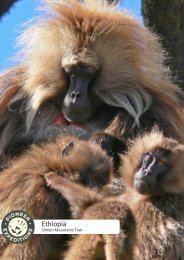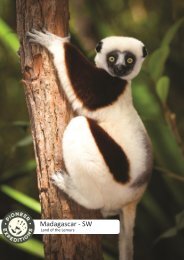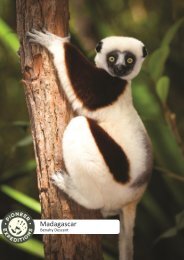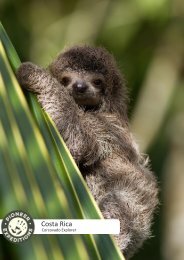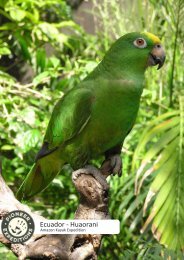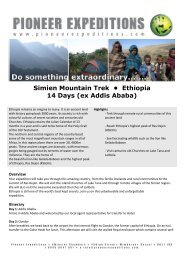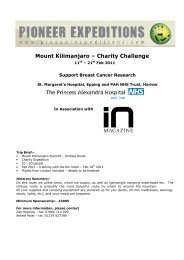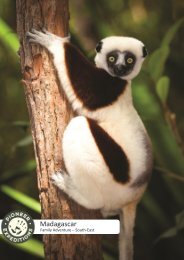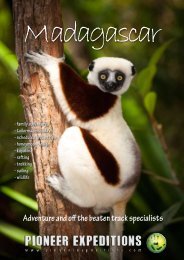Peru A3 draftl.indd - Pioneer Expeditions
Peru A3 draftl.indd - Pioneer Expeditions
Peru A3 draftl.indd - Pioneer Expeditions
You also want an ePaper? Increase the reach of your titles
YUMPU automatically turns print PDFs into web optimized ePapers that Google loves.
C O T A H U A S I C A N Y O N T R E K • P E R U<br />
16 DAYS • 15 NIGHTS<br />
This expedition explores the wild, remote region of the Andes mountain range<br />
around Cotahuasi in southern <strong>Peru</strong>. Below Cotahuasi the Cotahuasi river runs<br />
though the deepest canyon in the world. Although this canyon has been run by a<br />
handful of extreme rafting / kayaking expeditions this is a little trekked area with<br />
few organised expeditions. As far as is known, this <strong>Pioneer</strong> Expedition is the first<br />
group trek across the entire length of the canyon.<br />
This challenging expedition encompasses real adventure with the natural wonders<br />
and fascinating ancient history of the region. We will trek along wild and rocky<br />
trials accessible only by foot, encountering spectacular mountain scenery and<br />
picturesque hamlets deep in the canyon. We also visit the world’s largest<br />
petroglyph field with mysterious figures carved into the rocks, soak in steaming<br />
thermal baths and at 3500m above sea level, we shall visit the ‘Valley of Volcanoes’<br />
with its 80 small inactive cones.<br />
Do Something Extraordinary.....<br />
2 0 0 9 E X P E D I T I O N D O S S I E R<br />
Do you?<br />
Have a passion for the outdoors<br />
Want a challenging trek away off the beaten track<br />
Want to experience <strong>Peru</strong> and all its beauty<br />
Traversing the deepest canyon in the world (3354 m - 160m deeper than the nearby<br />
Colca Canyon), sometimes crossing the river using harnesses on cable crossings<br />
and over rustic but sturdy suspension bridges, will take ten days. Trekking through<br />
this impressive gorge a lot of time will be spent in unknown isolation with chances<br />
to see ancient civilisation, including evidence of past occupations, amphitheatres<br />
and the burial sites of the lost city of Marpa.<br />
The headwaters of the River Cotahuasi have their source in the Cordillera de<br />
Huanzo, a remote and very rarely visited part of the <strong>Peru</strong>vian Andes in the extreme<br />
north west of the Department of Arequipa, and discharge some 300km later into<br />
the Pacific Ocean as the River Ocoña. Although the Cotahuasi region was declared<br />
a Zona Reserva Turistica in 1988 very little was known about the area and even<br />
less about the canyon until a kayak / raft expedition first ran it in 1994.<br />
In pre-Colombian times the canyon was a more travelled route; an Inca road ran<br />
through most of the length and many sections still remain, as well as agricultural<br />
terracing and ruins. This Inca road may well have been based on routes previously<br />
built and used by the Huari culture, an important power in the highlands of central<br />
and southern <strong>Peru</strong> from 600-1000AD.<br />
SPECIAL HIGHLIGHTS<br />
• Trekking the entire length of<br />
the world’s deepest canyon,<br />
the remote Cotahuasi. With its<br />
spectacular scenery of lofty peaks<br />
and rushing rivers<br />
• Beautiful colonial architecture<br />
of the city of Arequipa<br />
• Spectacular altiplano and<br />
volcanic scenery<br />
Lima to Lima<br />
(land only)<br />
To reserve your place on this trip (without<br />
obligation and for up to two weeks) please<br />
telephone us on +44 (0)845 0047 801. To<br />
book please check availability, complete<br />
a booking form and return it to us. You<br />
should include a cheque for your deposit<br />
of £300/$600 with your booking form. On<br />
receipt of your booking form we will send<br />
you a booking acknowledgement, along<br />
with your joining instructions and all other<br />
information relevant to this trip. If you<br />
have any further questions regarding this<br />
trip please contact us. You can liaise with<br />
the expedition leader regarding all aspects<br />
of the trip pre-departure. Clients booked<br />
on this trip should make their way to the<br />
joining point in Lima, as detailed in the<br />
joining instructions.<br />
difficulty<br />
comfort<br />
exclusivity
ITINERARY<br />
Day 1 Arrive Lima<br />
Arrive in Lima, rendezvous with expedition<br />
leader and transfer to hotel. Lima was founded<br />
in 1535 as “City of the Kings” by Francisco<br />
Pizarro (Conquistador of the Incas) as his capital.<br />
Although earthquakes have destroyed the original<br />
city the historic centre contains many impressive<br />
colonial buildings from later periods, and the<br />
city also has many fi rst class museums, especially<br />
dealing with <strong>Peru</strong>’s impressive pre-Colombian<br />
history.<br />
Day 2 Fly to Arequipa<br />
An hour’s flight takes us to Arequipa (2,300m),<br />
<strong>Peru</strong>’s second city, set in a beautiful desert valley<br />
dominated by volcanoes. It is also known as “The<br />
White City” as much of the city is built from a<br />
white volcanic rock known locally as “sillar”, giving<br />
it a distinctive atmosphere. The historic centre<br />
has been declared a UNESCO heritage site and<br />
contains many fi ne colonial buildings and churches.<br />
Of particular interest are the Santa Catalina<br />
convent (a beautiful “mini-city” shut off from the<br />
outside world until the 1970s) and the Andean<br />
Sanctuaries Museum (containing frozen Inca<br />
human sacrifi ces discovered on nearby volcanoes<br />
by National Geographic expeditions).<br />
Days 3 Drive to Cotahuasi<br />
Leaving early, we set off into the spectacular<br />
mountain scenery around Arequipa. Our route<br />
initially follows the Pan American highway through<br />
the desert, then inland following the Majes river<br />
valley (well known for the production of wine<br />
and pisco, <strong>Peru</strong>’s national drink) before climbing<br />
towards the Andean mountains. We climb steeply<br />
to reach the high altiplano passing close to the<br />
mighty glacier covered fl anks of Coropuna (at<br />
6,425m the highest peak in southern <strong>Peru</strong>) and<br />
Solimana volcanoes. The road reaches around<br />
4750m in the highest section before dropping<br />
steeply to the village of Cotahuasi. Despite the<br />
bleak and hostile terrain, some interesting high<br />
altitude plants and wildlife species can be found in<br />
this region: the domestic South American llamas<br />
and alpacas are commonly seen grazing and with<br />
luck we will also see their beautiful and much<br />
rarer wild cousin - the vicuña.<br />
Day 4 In Cotahuasi (2680m)<br />
Cotahuasi is the main centre for exploring the<br />
network of valleys and canyons that contain the<br />
headwaters of the River Cotahuasi. A short<br />
drive takes us to the nearby highland village of<br />
Pampamarca and a chance to visit the bizarre rock<br />
formations at Huito and the Uskune waterfall.<br />
We return via the thermal baths at Luicho, an<br />
opportunity to soak and relax before beginning<br />
our trek through the canyon! Andean condors are<br />
present in the whole Cotahuasi region and with<br />
luck we will be able to spot one of these majestic<br />
birds (with a potential wingspan of over 3m!)<br />
soaring gracefully on thermals.<br />
Day 5 Trek through Cotahuasi Canyon to<br />
Mayu (1,800m; 7-8 hours approx)<br />
Below Cotahuasi the river, of the same name, has<br />
carved out the deepest canyon in the world. A<br />
short drive takes us closer to the start of the<br />
canyon at Sipia Bridge where we enter a wild<br />
rocky world only accessible by foot or raft/kayak.<br />
A short walk brings us to the Sipia waterfall,<br />
where the entire river plunges spectacularly over<br />
100m into a narrow fi ssure. From here the trail<br />
climbs before traversing along a narrow trail cut<br />
out of the canyon wall in places (not for vertigo<br />
sufferers!) to reach the small citrus growing village<br />
of Chaupo some 3 hours below Sipia. From<br />
Chaupo the trail levels and continues through<br />
giant cacti forests before passing below the hamlet<br />
of Velinga to our riverside camp at Mayu. A small<br />
thermal pool here gives us a chance to relax tired<br />
legs.<br />
Day 6 Trek through Cotahuasi Canyon to<br />
Quechualla (1700m; 6 -7 hours)<br />
Below Mayu we continue deeper into the canyon,<br />
at times following remains of the original pre-<br />
Colombian trail and passing the archaeological site<br />
of Huaña, consisting of the remains of storehouses<br />
& agricultural terraces that once lined this route<br />
TO BOOK: t: +44 (0)845 0047 801 e: info@pioneerexpeditions.com
Day 15 Fly to Lima<br />
We take an early morning fl ight back to Lima<br />
today where our expedition ends.<br />
For those of you wishing to spend a few extra<br />
days in Lima, <strong>Pioneer</strong> are happy to organise hotel<br />
accomodation.<br />
in ancient times. Beyond Quechualla we continue<br />
to reach the side valley of Uswa, the deepest<br />
point of the whole canyon. Quechualla itself is<br />
a pretty little hamlet with its streets covered in<br />
vines; grapes and wines are grown and produced<br />
here in season.<br />
Unlike Machu Picchu, the lost city of Marpa sees<br />
few visitors due to its inaccessible location and<br />
we can explore the terraced fields, amphitheatres<br />
and burial sites (Chulpas) in relative peace.<br />
Note: While our intention is to adhere to the<br />
day to day route as printed, a degree of fl exibility<br />
is built into the itinerary and night stops may vary<br />
from those suggested. The day to day schedule<br />
should be taken only as a general guide. We cannot<br />
accept responsibility for changing the proposed<br />
itinerary or any inaccuracies or errors. A variety of<br />
factors, including adverse weather conditions and<br />
diffi culties with transportation, can lead to enforced<br />
changes. The expedition leader will make any<br />
changes where necessary.<br />
Days 7 & 8 Trek through Cotahuasi<br />
Canyon via Huachuy (3,200m,) to<br />
Marpa (approx 1,500m)<br />
From Quechualla the trail climbs for several hours<br />
out of the canyon to reach the small highland<br />
village of Huachuy, at 3,200m the highest point of<br />
the trek.<br />
The next day is the longest and toughest day of<br />
our trek (approx 10-12 hours). We continue<br />
through the rugged scenery along the canyon’s<br />
rim to reach an abandoned mining camp on a<br />
ridge at Estacion. From here the trail begins<br />
a long steep rocky descent back down into the<br />
canyon to reach the ruins of Marpa. We camp<br />
below the site by the river.<br />
Day 9 The Lost City of Marpa<br />
Days 10-13 – Trek through Cotahuasi<br />
Canyon to Barrera (5-6 hours per day)<br />
Below Marpa the canyon is hardly known except<br />
to a few river runners; the route continues<br />
beneath rocky walls, with sections of the original<br />
trail and archaeological remains showing that it<br />
was once an important route in pre-Colombian<br />
times.<br />
On day 12, the rivers Marán and Chachas join the<br />
Cotahuasi in quick succession to form the River<br />
Ocoña, which continues to the Pacific Ocean<br />
; near the second confl uence is the village of<br />
Chaucalla (900m). Below here the canyon starts<br />
to open out and we have fi nally reached the<br />
Andean foothills and lowlands. We spend the fi nal<br />
night of the trek at Barrera.<br />
Today is a well deserved rest day, where we can<br />
explore the ruins of Marpa. These are by far the<br />
largest in the canyon; it is possible the site once<br />
covered an area similar in size to Machu Picchu.<br />
Probably dating initially from the Huari period,<br />
extensive areas of terracing as well as residential<br />
areas cover the steep canyon walls on both<br />
sides of the river, showing that the ability to<br />
plan and build cities on steep mountainsides was<br />
not confined to the Incas! We spend a day here<br />
to relax and explore this impressive site more<br />
thoroughly.<br />
Day 14 Drive from Barrera to Arequipa<br />
In Barrera we meet our transport for a full day’s<br />
drive following a rough road on down the Ocoña<br />
River valley to meet the Pan American highway;<br />
which takes us through <strong>Peru</strong>’s rugged desert<br />
coastal plain before climbing into the mountains<br />
back to Arequipa.<br />
<strong>Pioneer</strong> <strong>Expeditions</strong><br />
The Well House<br />
Chydyok Road<br />
East Chaldon<br />
Dorset<br />
DT2 8DN<br />
tel: +44 (0)845 0047 801<br />
info@pioneerexpeditions.com<br />
extraordinary expedition firsts..
PRACTICAL INFORMATION<br />
VISA REQUIREMENTS<br />
Tourist visas are not required for citizens<br />
of UK and USA. Visitors are normally<br />
given permission to stay for up to 90<br />
days on arrival. Passports should be<br />
valid for at least 6 months beyond the<br />
intended dates of stay. In case of queries<br />
you should consult the <strong>Peru</strong>vian consular<br />
representatives in your country. Note that<br />
some flights to <strong>Peru</strong> transit the USA - you<br />
should check latest visa situation with your<br />
US Embassy or Consulate.<br />
FLIGHTS<br />
International flights are not included.<br />
Internal return flights from Lima<br />
to Arequipa and all other surface<br />
transportation is included. If you require<br />
information regarding airlines and routes<br />
please contact us.<br />
Nothing compulsory, though protection<br />
against tetanus, typhoid, hepatitis and<br />
polio is recommended. You should consult<br />
your doctor or travel clinic for up to<br />
date advice. Note that malaria, dengue<br />
and yellow fever are present in <strong>Peru</strong> but<br />
normally confined to Amazon and jungle<br />
regions.<br />
¡¢¢£¤¡¥£¦¤¡¤§¨©¦¥¢¥£¦¤<br />
INSURANCE<br />
Adequate travel insurance is mandatory<br />
for everyone who participates in a <strong>Pioneer</strong><br />
expedition. Please bring a copy of your<br />
insurance policy and contact numbers to<br />
give to your expedition leader in case of<br />
illness or accident.<br />
ACCOMMODATION<br />
Where possible we will stay in first<br />
class accommodation, though please<br />
bear in mind outside the main cities<br />
accommodation is likely to be basic<br />
and limited, we will stay in the best<br />
available. During the trek we will be<br />
travelling in remote, rugged terrain and<br />
accommodation will be in 2 person tents.<br />
If you require accommodation either<br />
before or after the trip, we can book this<br />
for you (subject to availability) provided<br />
you notify us at the time of booking.<br />
Payment for this should be made to<br />
<strong>Pioneer</strong> before departure.<br />
<br />
EXPEDITION TEAM<br />
Maximum group size is 8 plus <strong>Pioneer</strong><br />
expedition leader, English speaking local<br />
guides, local expedition crew, including<br />
muleteers, drivers and cooks.<br />
TRANSPORT<br />
We have internal return flights between<br />
Lima and Arequipa. Private 4 wheel drives<br />
are used for the drive from Arequipa to<br />
Cotahuasi, and private transport for our<br />
return journey after the trek.<br />
PERSONAL EXPENSES<br />
This is a fully inclusive expedition from<br />
days 3 to 18. All entrance fees, guiding,<br />
logistics, hotels and most drinks are<br />
included. Not included are visas, tips,<br />
optional excursions and personal expenses.<br />
US dollars and Euros can easily be changed<br />
into <strong>Peru</strong>vian Soles. ATMs are available in<br />
both Lima and Arequipa and take most<br />
common debit/credit cards. Travellers<br />
cheques in US Dollars or Euros can be<br />
changed in most towns but involve more<br />
bureaucracy than cash. Credit cards can be<br />
used in more up market places in major<br />
towns.<br />
BAGGAGE<br />
Baggage should be kept to a minimum as<br />
for much of the trip it will be carried by<br />
mules. A rucksack or army style kit / duffel<br />
bag is ideal for this; you will also need a day<br />
pack that is large enough to comfortably<br />
carry what you will need during the day on<br />
the trek (30-45 litre capacity is normally<br />
adequate). A small additional lockable kit<br />
bag will enable you to leave any spare<br />
clothes or luggage you don’t need while we<br />
are trekking in our hotel in Arequipa.<br />
MEAL PLAN<br />
Whilst driving and trekking in Cotahuasi<br />
all meals (breakfast, lunch and dinner) are<br />
included. Only breakfast is included in<br />
Lima and Arequipa. Food will be prepared<br />
by our cooks whilst trekking and we will<br />
use locally sourced fresh produce where<br />
possible.<br />
As with all <strong>Pioneer</strong> expeditions, we are<br />
committed to maximising the benefi ts<br />
of our trips to the local community and<br />
minimising the negative impact associated<br />
with tourism. We employ local agents<br />
and staff, not just to benefi t the local<br />
economy, but also to give you a real sense<br />
of <strong>Peru</strong>vian culture. To greatly reduce our<br />
impact on the environment there is a<br />
maximum of 8 team members, which helps<br />
to minimise the damage associated with<br />
large scale tourism.<br />
<br />
Although no special experience is required,<br />
it is expected that clients will have an<br />
above average level of fitness and some<br />
mountain walking experience carrying day<br />
packs. Most days on the trek will involve<br />
5-7 hours of walking with a couple of<br />
longer tougher days (longest day estimated<br />
to be 10-12 hours). Terrain will involve<br />
rough, rocky, steep loose paths in sections,<br />
with a couple of long ascents and descents;<br />
short ascents and descents will be<br />
commonplace. One section of the trek on<br />
the first day will involve a cliff-side trail not<br />
!"#$<br />
recommended for vertigo sufferers.<br />
Note that short periods of the tour will<br />
be spent at altitude. The highest altitude<br />
reached will be around 4700m briefl y<br />
during the drive between Arequipa and<br />
Cotahuasi, and we will spend one night at<br />
around 3500m at Andagua on this route.<br />
Most of the trek will be below 2500m,<br />
apart from one night spent at Huachuy at<br />
approx 3100m.<br />
#<br />
Personal Clothing<br />
• Personal Clothing<br />
•<br />
Strong well broken in walking boots<br />
with ankle support (trails in the canyon<br />
will involve some steep sections on rough,<br />
loose rocky paths)<br />
Comfortable walking socks and liner socks<br />
•<br />
• Sports sandals/lightweight shoes for use in<br />
town and around camp<br />
• Lightweight breathable long sleeved tops<br />
and trousers for trekking<br />
• Warm top / fl eece<br />
• Thermal underwear for a couple of colder<br />
nights at altitude<br />
• Lightweight breathable waterproofs<br />
• Sunhat<br />
• Swimming costume / shorts and<br />
lightweight towel<br />
Equipment<br />
•<br />
•<br />
Personal first aid kit including blister kit<br />
Rucksack/kit bag (to be carried by mules<br />
on trek)<br />
• Day pack to carry what you need during<br />
the day on trek (30-45 litre capacity)<br />
• Lightweight sleeping mattress / thermarest<br />
• Sleeping bag (suggest 2-3 season; with<br />
thermal underwear layers for one colder<br />
night on trek)<br />
• Torch and spare batteries<br />
• Large (2 litre) water bottle and iodine<br />
tablets<br />
• Insect repellent<br />
• Sun block, hat and glasses<br />
• Biodegradable soap<br />
• Binoculars if interested in wildlife<br />
• Trekking poles if preferred<br />
Group Equipment Provided<br />
during Trek<br />
• 2 person tents<br />
• Cooking equipment, utensils and food<br />
• Mules and muleteers (including spare<br />
mules in case of emergencies)<br />
• Medical kit<br />
• Harnesses for cable crossings in the<br />
canyon




